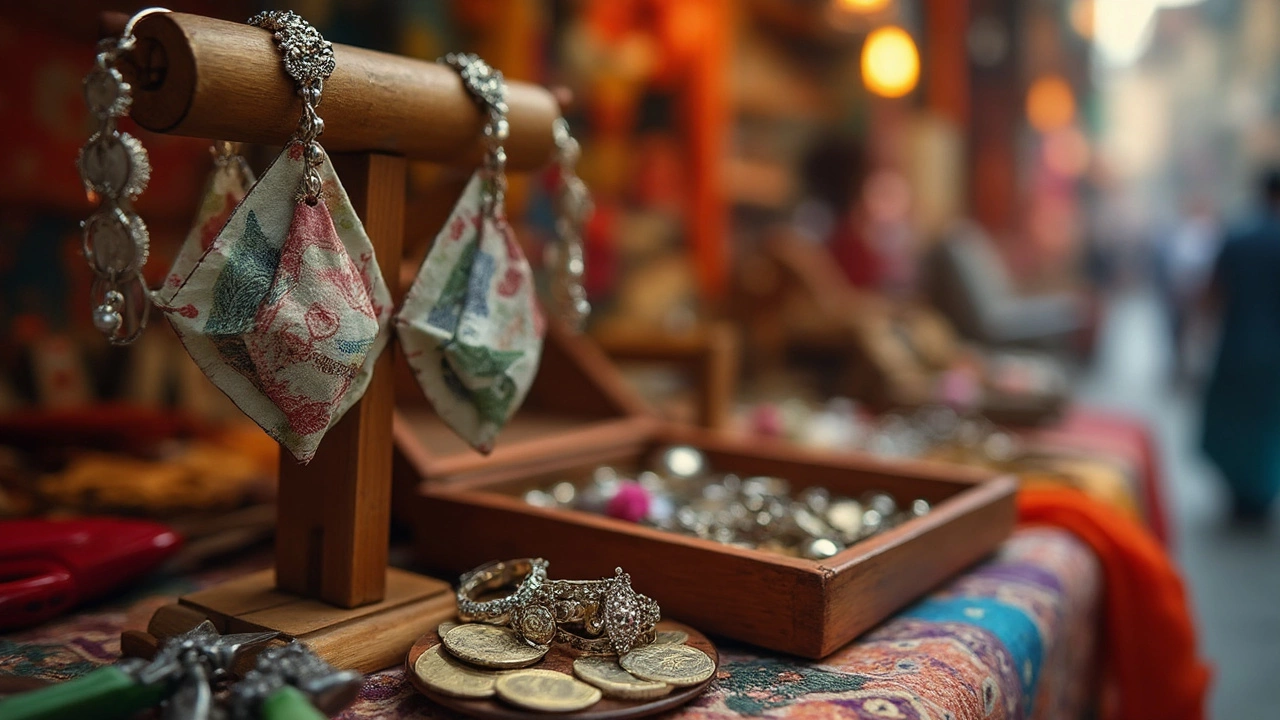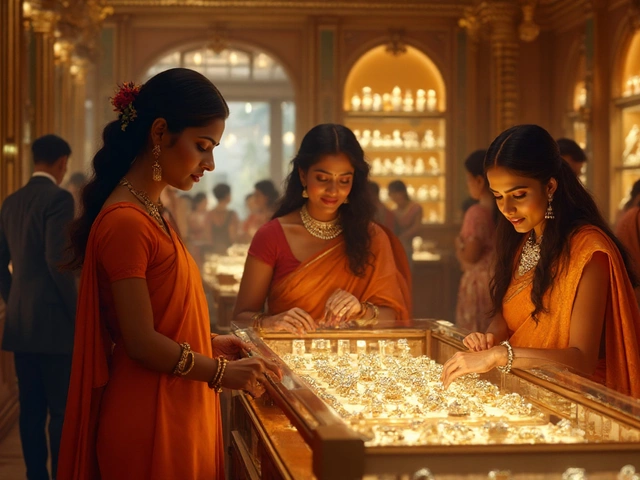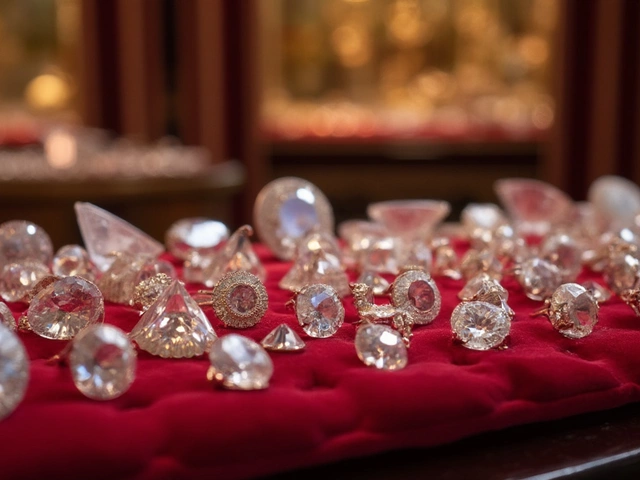
Ever seen a ring made from a quarter or a bracelet with little coins dangling from it? It's a cool trend, but it instantly raises a big question—can you get in trouble for making jewelry out of real money?
Turns out, the answer is not as simple as yes or no. Laws around using cash for crafts are complicated, and they’re not always the same around the world. If you're the crafty type who loves using jewelry making kits, or you're just curious if you can legally rock a coin necklace, here's what actually matters: most places care about whether the money can still work like real money afterward. Once you know what to watch out for, you can get creative without stressing about a surprise knock on your door from the police.
This article sorts out the rules, cuts through the legal jargon, and serves up tips for making your own money jewelry that looks good and keeps you out of trouble. You'll get real info—not myths—about how coin jewelry is treated by the law and who should think twice before breaking out the pliers.
- Why People Make Jewelry Out of Money
- The Legal Side: What the Law Actually Says
- Is It the Same Everywhere? US vs the World
- What Kinds of Money Jewelry are Risky?
- Practical Tips for Safe Money Jewelry Making
- Creative Alternatives without Breaking the Law
Why People Make Jewelry Out of Money
People love the idea of turning something common, like coins or bills, into something special they can wear. It’s not just about showing off—lots of folks have deep, personal reasons for making jewelry out of cash. For some, a coin from a special year marks a big event, like a graduation or a wedding. Others just enjoy the thrill of making something unique you can’t buy at a mall.
Collectors and crafters often use coins from places they traveled, or even out-of-circulation currency, as a way to keep memories close. You’ll find families handing down a bracelet made from pennies collected by a grandparent. It’s one way to keep family stories alive in a wearable form.
The trend got a boost during the Great Depression in the U.S. People made jewelry out of coins because it was cheap, creative, and let them reuse what they already had. This practice, called "hobo nickel" art, is still popular, especially among folks who use money jewelry to mix history, craftsmanship, and a bit of rebellion.
Sometimes it’s just about the look—old coins can be surprisingly stylish. Silver half dollars, for example, have a rugged shine that stands out when made into rings or pendants. Folks with jewelry making kits at home like coins because they’re easy to cut, punch, and bend compared to lots of other materials.
- Commemorate special dates
- Hold onto souvenirs or memories
- Create family heirlooms
- Express creativity and personal style
- Save money on jewelry materials
| Popular Coin Jewelry Types | Origin Year or Era |
|---|---|
| Hobo Nickel Art | 1930s U.S. |
| Smashed Penny Souvenirs | Early 20th Century |
| Coin Rings | Modern (but started in 1800s) |
| Pendant Necklaces from Coins | Victorian Era & Today |
So yeah, there’s more to coin jewelry than just looking cool. There’s history, art, thriftiness, and some serious DIY spirit behind every piece.
The Legal Side: What the Law Actually Says
The law isn’t trying to ruin your fun, but it does care what you do with your money—especially when you start turning it into jewelry. In the US, the main rules come from Title 18, Section 331 of the United States Code. It says it’s illegal to fraudulently alter, deface, or mutilate coins. The keyword here is “fraudulently.” That means, if you turn coins into jewelry but you’re not trying to pass them off as regular coins or trick anyone, you’re usually not risking jail. Turning an ordinary quarter into a pendant is not the same as shaving metal off coins to melt and sell it, which would be a problem.
For paper bills, Title 18, Section 333 lays out similar rules, making it a crime to mutilate, cut, or destroy currency with intent to render it unusable. But the Secret Service—which actually deals with currency crimes—has said in public statements that making art or jewelry from cash isn’t a priority, unless your project is so extreme that the bill is unrecognizable and can’t be used at all. Basically, if that one-dollar origami earring could still be opened up and used, you’re probably in the clear.
Check out this quick overview:
| Type of Money | Legal Focus | Action That Gets You in Trouble |
|---|---|---|
| US Coins | No fraud or mass destruction | Shaving, melting, changing value |
| US Paper Bills | Can't make bills unusable | Completely destroying or defacing |
Other countries have their own spins. For example, the UK’s Coinage Act 1971 bans melting down coins, but just crafting jewelry from coins without damaging them usually gets shrugged off. Canada outlaws defacing or destroying coins, with pretty much the same vibe as the US. And Australia? They actually sell blanks for jewelry making, so you can make pieces that look like coins without breaking the law at all.
So, to keep things simple: don’t destroy or try to trick people with your creations and your money jewelry projects should go off without a hitch. The big risk comes from trying to alter coins or cash so much that it can’t work as money anymore, or if you try to melt coins for the metal. Stick to visible, honest crafting, and you’ll avoid serious legal headaches.
Is It the Same Everywhere? US vs the World
So, does every country treat money jewelry laws the same way? Not even close. In the US, the law is clear on one thing: it’s illegal to deface coins or paper bills with the intent to make them unusable as money. But there’s a twist—if you’re not trying to commit fraud or reuse the money as legal tender, and you’re just making art or jewelry, you’re usually in the clear. The Secret Service has even said in interviews they care more about counterfeiting than about some pennies turned into cufflinks. But that doesn’t mean you’re free to do whatever you want—especially if you want to sell your creations.
Jump across the Atlantic and things get a bit stricter. In the UK, it’s straight-up illegal to mutilate banknotes, but coin-altering isn’t as tightly monitored, unless you’re melting them down in bulk for the metal. In Canada, they’ve gotten rid of the penny, but it’s still illegal to melt or destroy coins for profit. Australia is pretty relaxed about modified coins as souvenirs, but if you tamper with notes, you’re asking for trouble.
Check this out:
| Country | Defacing Coins | Defacing Notes |
|---|---|---|
| USA | Allowed if not for fraud | Illegal if intent to defraud |
| UK | Mostly allowed unless melted for profit | Illegal |
| Canada | Illegal to melt; modding OK | Illegal |
| Australia | Souvenirs OK | Illegal |
It gets even trickier in places like Singapore and India where any kind of money mutilation—coins or notes—can lead to big fines or jail time. That means using their currency in your next jewelry making kit project is just asking for headaches.
If you’re selling your creations online, things can get sticky fast. Shipping money jewelry across borders might violate import laws, even if what you did was totally legal at home. When in doubt, look up the rules for the country you’re in or shipping to. Better safe than stuck explaining your coin necklace to customs agents.

What Kinds of Money Jewelry are Risky?
If you're thinking about making money jewelry, not every piece is treated the same. Some types are straight-up risky, while others are usually fine for personal use.
Here’s the main thing: Laws tend to care about whether your craft turns money into something totally useless as cash. In the U.S., for example, the law (18 U.S.C. § 333) specifically says you can’t mutilate coins “with the intent to defraud.” Just flattening a penny for a bracelet or drilling a hole in a quarter for a keychain? That’s almost always okay, as long as your goal isn’t to fake or scam cash.
But if you grab a stack of bills and start cutting and gluing them into something new, things get a bit murkier—especially with paper money. The laws about defacing bills are stricter in some countries, and sometimes they don’t spell out what “defacing” actually means.
- Turning coins into rings: Fine for personal use in most places, but selling in bulk might raise questions.
- Flattening pennies in souvenir machines: This is legal in the U.S. if you’re not trying to pass the penny back as real change.
- Cutting up paper bills for detailed designs: This can get you flagged, especially if you’re destroying lots of them. Counterfeiting is a big concern here, so don’t do anything that could make fake bills.
- Making jewelry out of rare or collectible coins: Risky—destroying or even altering valuable coins can break numismatic or historical preservation laws, not just money laws.
If you’re ever unsure, check what government agencies actually say about using money for crafts. In some cases, folks have been fined, like in Singapore where even minor defacing of paper currency can mean a $200 penalty. In the UK, damaging coins for jewelry can also carry a small fine (up to £400) if you start selling them.
| Type of Money Jewelry | Legal Risk (USA) | Legal Risk (Europe/UK) |
|---|---|---|
| Coin Rings | Low (personal), Medium (commercial) | Medium |
| Penny Pressed Souvenirs | Low | Low |
| Paper Bill Earrings | Medium | High |
| Cut Coins (Art) | Low to Medium | Medium |
| Rare Coin Alteration | High | High |
Quick tip: Before you make or sell anything, check the latest rules in your country. Most serious legal trouble comes from obvious abuse—like making fake cash, huge sales, or wrecking rare coins. Just making a single penny pendant at home? You’ll probably be fine.
Practical Tips for Safe Money Jewelry Making
If you’re thinking about turning coins or bills into jewelry, you’ll want to stay on the right side of the law. Here’s what you need to know before you pop open your money jewelry kit.
First off, not all money is treated the same legally. In the United States, you can legally make jewelry out of coins as long as you don’t try to pass them off as regular money afterward. Federal law (18 U.S.C. § 331) actually says it’s illegal to fraudulently alter coins, but simply turning a penny into a pendant is usually fine if you never use it as cash. When it comes to paper bills, the Secret Service technically frowns on mutilation, but if you’re making a single necklace for personal use, you’re probably safe. Selling bill jewelry in bulk can be riskier, especially if the bills are still recognizable.
Here are some tips to help keep things easy and stress-free:
- Use coins already out of circulation. Old coins, foreign currency, or commemorative pieces are less likely to raise issues.
- Avoid destroying high-value money. Don’t punch a hole in a rare silver dollar—check its value first on a coin site or app.
- Alter money so it’s no longer usable. Bend, drill, or otherwise change it so it can’t go back into circulation. A quarter with a big hole through it? No cashier’s taking that.
- Label your items as jewelry, not currency. Sell or display them as crafts to make it clear you aren’t trying to scam anyone.
- Stay away from large batches. Making one-off personal pieces is usually fine. Mass production (like 100-dollar-bill earrings for an online shop) starts to look sketchy, at least in the US.
Check out how different items tend to be viewed:
| Item | Legal Risk | Extra Tip |
|---|---|---|
| Quarter ring | Low | Bend or engrave to show it’s jewelry |
| Penny earrings | Low | Best with older or foreign pennies |
| Paper bill bracelet | Medium | Use damaged or novelty bills if possible |
| Rare coin necklace | High | Check collector value first—don’t destroy rare coins |
Finally, even if the law is on your side, some people still view turning money into jewelry as disrespectful or wasteful. If you run a jewelry making business, drop a note explaining your process and the history of the coins you use—people love a good backstory, and it can help you dodge misunderstandings.
Creative Alternatives without Breaking the Law
If you love the look of money jewelry but want zero legal worries, you’ve got smarter options. Making jewelry that’s inspired by cash or coins can be just as striking—without the risk of fines or breaking rules. Let’s get practical with some DIY ideas and proven facts.
First, check out materials you can use to mimic coins or bills without touching real money. Tons of money jewelry on Etsy and at craft fairs is made from replica coins, metal blanks, or even plastic. These pieces look authentic and nobody’s going to chase you down just for being creative.
- Replica coins and notes: Most craft stores and online sellers carry faux coins and bills. They’re usually stamped "Copy" on one side (required by U.S. law), and they’re super cheap for bulk packs.
- Metal stamping blanks: These are flat metal discs made of brass, copper, or aluminum—perfect for making coin-shaped pendants or charms.
- Polymer clay: Mold this soft clay to make almost any design. You can shape it into coins, paint it metallic, or add designs that look like real currency.
- Resin art: People use tiny images of bills or coins printed on paper, sealed in resin to get a lightweight, glossy effect. No need for actual money here.
Here’s a quick breakdown of popular alternatives for making jewelry that looks like cash:
| Material | Legal Risk | Durability | Available At |
|---|---|---|---|
| Replica Coins | None | High | Online, Craft Stores |
| Stamping Blanks | None | High | Jewelry Supply Shops |
| Polymer Clay | None | Medium | Art/Craft Stores |
| Resin with Paper Prints | None | Medium | Online, DIY Kits |
For folks who love real-coin looks, there’s a big tip: keep all coins or bills untouched, and use bezel settings or coin holders to showcase them in jewelry. This way, you’re not damaging the currency, just framing it. Some rare coin collectors do it all the time and it’s totally safe legally in the U.S. when you don’t drill, flatten, or melt the coin.
Lots of jewelry making kits even include fake bills or coin charms, taking any guesswork out of what’s allowed. When in doubt, pick kits or supplies that clearly say "for decorative use only" or "not legal tender." This is an easy way to get bold designs without headaches.
Short on supplies? You can find tutorials online to print your own faux money designs—just don’t make them the same size as real cash (smaller or larger is fine). The U.S. Secret Service has said they’re only concerned with copies that could be confused for actual money.
If you want flashy, legal, and personal accessories, these alternatives are safer and honestly more fun to experiment with than risking a real bill. Get creative, follow the tips, and show off your style without any legal drama.


